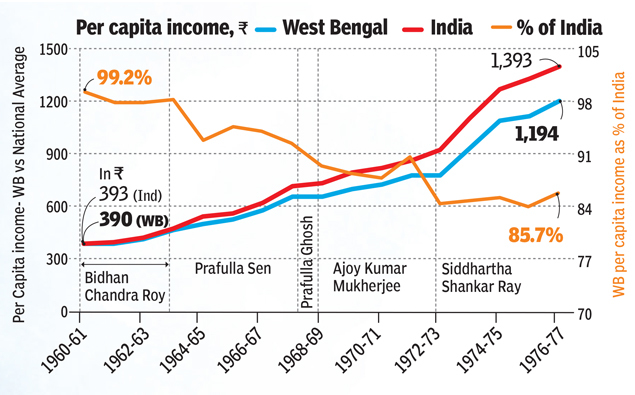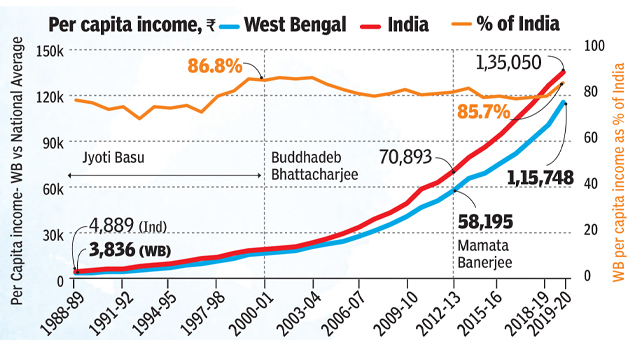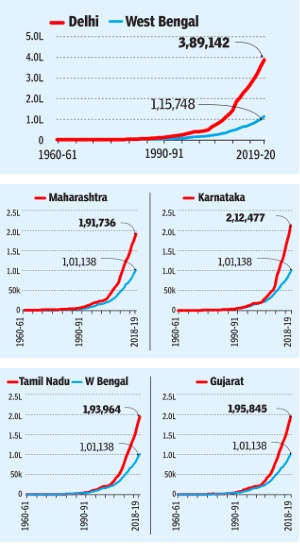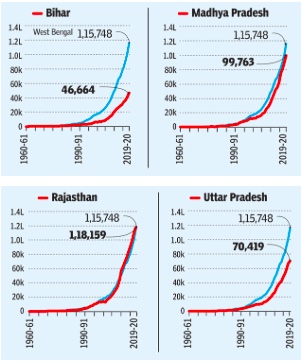West Bengal: economy
This is a collection of articles archived for the excellence of their content. |
History
Growth: 1960-2020
Atul Thakur, April 6, 2021: The Times of India

From: Atul Thakur, April 6, 2021: The Times of India

From: Atul Thakur, April 6, 2021: The Times of India

From: Atul Thakur, April 6, 2021: The Times of India

From: Atul Thakur, April 6, 2021: The Times of India
It was one of British India’s most industrialised regions, but during the 1960s West Bengal fell behind economically. Its per capita income declined. Partition and the resultant refugee influx, dependence on industries like jute, mining and tea, and lack of diversification caused the setback, but the mid-70s arrested the state’s slide. Although West Bengal has not regained its past glory, its per capita GDP has largely kept pace with the national average since then.
Why state’s per capita income fell after Partition
West Bengal’s per capita income started falling after 1947 for several reasons explained below. But even at the start of the 1960s, it was equal to the national average. As successive governments failed to stop the decline over the next 15 years, it touched 85% of the national per capita income in the mid-1970s and has fluctuated around that mark ever since
Raw material shortage
The Partition of India separated Kolkata’s mills from the jute growing areas in Bangladesh. It also increased the distance between Kolkata – a tea export hub – and the tea gardens in Assam, Tripura, etc. The time and cost of transporting raw materials increased.
Lakhs of refugees
The flow of refugees into West Bengal started in 1946 and continued for decades. It increased immensely during 1971 when 60 lakh people were officially estimated to have crossed over from the Bangladesh side. This heavily burdened the state’s already stressed economy.
Nylon replaces jute
After the Second World War, nylon replaced jute as the primary packaging material, and other countries – Kenya, Sri Lanka, Vietnam and Indonesia – emerged as major exporters of cheaper varieties of tea.
Subsidy for transporting minerals
Experts say a government policy to boost industrialisation all over India hurt the economic prospects of West Bengal and other mineral-rich states. Under the ‘Freight Equalisation Scheme’, the Centre subsidised long-distance transport of raw materials for manufacturing iron, steel, cement, etc. So, mineral-rich states lost their locational advantage. By some estimates, the incentive was just enough to move production to richer states in the west from poor eastern states.
1980s: Land reforms boost rural economy, raise income
Soon after being elected, the Left Front government started ‘Operation Barga’ – West Bengal’s land reforms. Together with better irrigation, this gave a push to the rural economy, leading to a steady rise in income. The Left government, however, failed to reverse the state’s de-industrialisation.
2000s: Per capita income remains below national average
Although land reforms helped raise West Bengal’s per capita income, liberalisation in the 1990s created more opportunities in other states. Bengal’s per capita income fell further behind the national average in the late 1980s and early 1990s. In the late-1990s, it rose to roughly 80% of the national average and has since remained in the 80-90% range.
Lack of industry and Centre-state differences are holding back growth
Lack of diversification of industrial produce in West Bengal, and differences between the state’s Left Front government and the market-liberal government at the Centre may have enabled other states to gain more from Liberalisation.
Bengal remains ahead of Bihar, MP and UP, but behind Rajasthan
Economic data clearly shows that claims about West Bengal’s economy being in free fall since Independence are not true. Compared with the Bimaru states (poorest among major states) the state has done well.
Note: All data for NNI per capita, at current prices, in INR; 2019-20 data not available for all states
Source: Mospi
